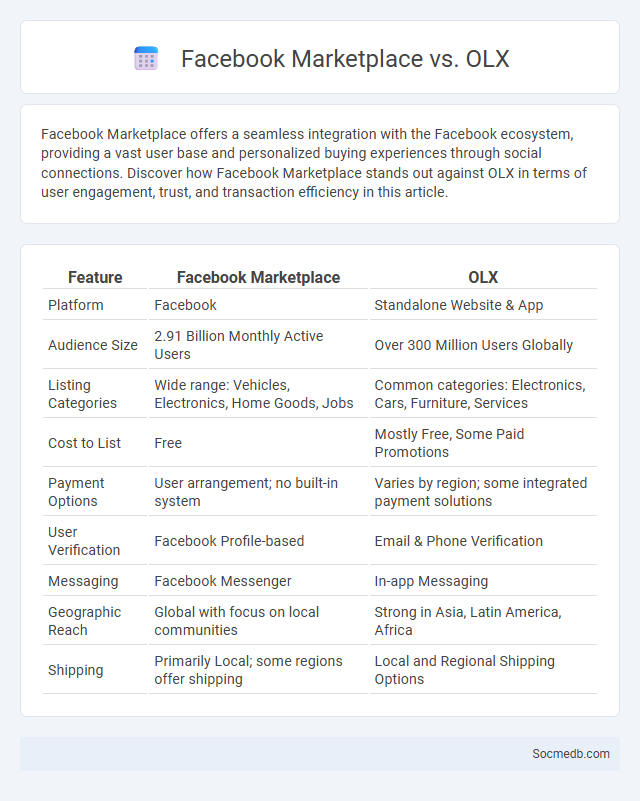
Photo illustration: Facebook Marketplace vs OLX
Facebook Marketplace offers a seamless integration with the Facebook ecosystem, providing a vast user base and personalized buying experiences through social connections. Discover how Facebook Marketplace stands out against OLX in terms of user engagement, trust, and transaction efficiency in this article.
Table of Comparison
| Feature | Facebook Marketplace | OLX |
|---|---|---|
| Platform | Standalone Website & App | |
| Audience Size | 2.91 Billion Monthly Active Users | Over 300 Million Users Globally |
| Listing Categories | Wide range: Vehicles, Electronics, Home Goods, Jobs | Common categories: Electronics, Cars, Furniture, Services |
| Cost to List | Free | Mostly Free, Some Paid Promotions |
| Payment Options | User arrangement; no built-in system | Varies by region; some integrated payment solutions |
| User Verification | Facebook Profile-based | Email & Phone Verification |
| Messaging | Facebook Messenger | In-app Messaging |
| Geographic Reach | Global with focus on local communities | Strong in Asia, Latin America, Africa |
| Shipping | Primarily Local; some regions offer shipping | Local and Regional Shipping Options |
Introduction to Online Marketplaces
Online marketplaces revolutionize social media by integrating e-commerce functionalities directly within platforms like Facebook, Instagram, and TikTok. These digital marketplaces enable users to discover, browse, and purchase products without leaving the social media environment, enhancing customer engagement and streamlining the buying process. Leveraging user data and advanced algorithms, social media-driven marketplaces offer personalized shopping experiences that drive higher conversion rates and foster brand loyalty.
Overview of Facebook Marketplace
Facebook Marketplace offers a robust platform for buying and selling goods locally, providing users with an extensive range of categories from electronics to household items. Your listings gain visibility through Facebook's vast user base, enabling convenient connections with potential buyers or sellers nearby. The platform integrates seamlessly with Facebook profiles, enhancing trust and simplifying communication during transactions.
Key Features of OLX
OLX excels in user-friendly social media integration, allowing seamless sharing of listings across platforms like Facebook and WhatsApp to boost your item's visibility. Its advanced search filters and location-based services connect buyers and sellers efficiently within your community, enhancing transaction speed. The platform's secure chat and negotiation tools ensure safe and transparent communication, making OLX a powerful social media marketplace.
What Sets Marketplace Apart?
Marketplace stands out for its seamless integration of social commerce features, enabling users to buy and sell products within their social networks effortlessly. It leverages advanced algorithms to offer personalized product recommendations, enhancing user experience and engagement rates. The platform's robust security measures ensure safe transactions, setting it apart from traditional social media marketplaces.
User Interface and Experience Comparison
User Interface (UI) and User Experience (UX) significantly influence how you interact with social media platforms like Instagram, Facebook, and Twitter. Instagram emphasizes a visually appealing, minimalistic UI that enhances image and video presentation, creating an immersive UX focused on content discovery. Facebook offers a complex UI with numerous features and a customizable news feed, prioritizing social interaction, while Twitter delivers a streamlined, text-centric UI designed for quick information sharing and real-time updates.
Listing and Selling Process
Social media platforms streamline the listing and selling process by enabling sellers to create detailed product listings with images, descriptions, and pricing directly within the app. Integrated shopping features like Instagram Shopping and Facebook Marketplace allow buyers to browse, inquire, and purchase items without leaving the platform. Real-time messaging and feedback systems enhance communication between sellers and buyers, ensuring a smooth transaction experience.
Buyer-Seller Communication Tools
Buyer-seller communication tools on social media platforms enhance real-time interaction, enabling personalized customer support and quicker response times. Features like direct messaging, chatbots, and comment management systems facilitate seamless engagement and increase conversion rates. Integrating these tools with analytics allows businesses to track user behavior and optimize marketing strategies effectively.
Safety Measures & Trustworthiness
Ensuring your safety on social media involves using robust privacy settings, enabling two-factor authentication, and regularly reviewing account activity for suspicious behavior. Trustworthiness is built through verified profiles, transparent content policies, and reliable fact-checking mechanisms that protect users from misinformation. Implementing these safety measures enhances your online experience and fosters a secure, credible social media environment.
Pricing, Fees, and Monetization
Social media platforms offer various pricing models, including subscription fees, advertising costs, and transaction charges that affect your budget. Monetization opportunities include influencer partnerships, sponsored content, and in-app purchases designed to maximize revenue streams. Understanding each platform's fee structure is essential to optimize your social media marketing strategy and increase profitability.
Which Platform Is Best for You?
Choosing the best social media platform depends on your goals and target audience. Instagram excels for visual content and influencer marketing, while LinkedIn is ideal for professional networking and B2B connections. Facebook offers broad reach with diverse demographics, and TikTok is perfect for engaging younger audiences with short, creative videos.
 socmedb.com
socmedb.com